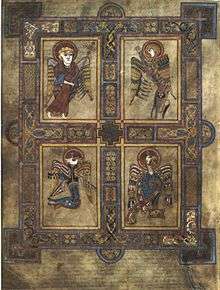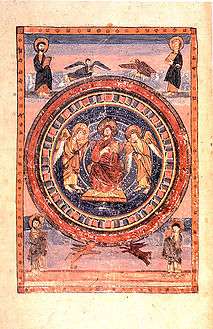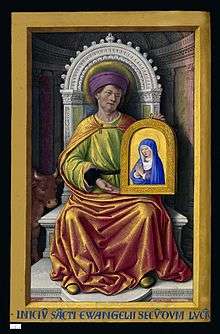Four Evangelists

In Christian tradition, the Four Evangelists are Matthew, Mark, Luke, and John, the authors attributed with the creation of the four Gospel accounts in the New Testament that bear the following titles: Gospel according to Matthew; Gospel according to Mark; Gospel according to Luke and Gospel according to John.
Gospels


The gospels of Matthew, Mark, and Luke are known as the Synoptic Gospels, because they include many of the same stories, often in the same sequence. While the periods to which the gospels are usually dated suggest otherwise,[1][2] convention traditionally holds that the authors were two of the Twelve Apostles of Jesus, John and Matthew, as well as two "apostolic men,"[3] Mark and Luke:
- Matthew – a former tax collector who was called by Jesus to be one of the Twelve Apostles,
- Mark – a follower of Peter and so an "apostolic man,"
- Luke – a doctor who wrote what is now the book of Luke to Theophilus. Also known to have written the book of Acts (or Acts of the Apostles) and to have been a close friend of Paul of Tarsus,
- John – a disciple of Jesus and the youngest of his Twelve Apostles.
They are called evangelists, a word meaning "people who proclaim good news," because their books aim to tell the "good news" ("gospel") of Jesus.[4]
Symbols
In iconography, the evangelists often appear in Evangelist portraits derived from classical tradition, and are also frequently represented by the symbols which originate from the four "living creatures" that draw the throne-chariot of God, the Merkabah, in the vision in the Book of Ezekiel (Chapter 1) reflected in the Book of Revelation (4.6-9ff), though neither source links the creatures to the Evangelists. Images normally, but not invariably, appear with wings like angels.[5][6]
English trans. of 3rd edn,
The meanings accruing to the symbols grew over centuries, with an early formulation by Jerome,[5] and were fully expressed by Rabanus Maurus, who set out three layers of meaning for the beasts, as representing firstly the Evangelists, secondly the nature of Christ, and thirdly the virtues required of a Christian for salvation:[6] These animals may have originally been seen as representing the highest forms of the various types of animals, i.e., man, the king of creation as the image of the creator; the lion as the king of beasts of prey (meat-eating); the ox as the king of domesticated animals (grass-eating) and the eagle as the king of the birds.

- Matthew the Evangelist, the author of the first gospel account, is symbolized by a man. Matthew's gospel starts with pointing Jesus as the son of David, son of Abraham. It then proceed with genealogy starting from Abraham. David was mention first as this gospel to presents Jesus' as King and speaks a lot of Kingdom of Heaven.
- Mark the Evangelist, the author of the second gospel account, is symbolized by a winged lion – a figure of labourous worker. It did not mention genealogy, as it is not of importance for servant.
- Luke the Evangelist, the author of the third gospel account (and the Acts of the Apostles), is symbolized by a winged ox.– a figure of Jesus as our High Priest, a man that represent man to God. The genealogy go all the way back to Adam. The gospel starts off with a "mute" Hight Priest that can not bless, and ends with Jesus blessing its disciple as He being lifted up to Heaven. Which tells Christian that we now have Jesus that represent us before God in Heaven as our High Priest.
- John the Evangelist, the author of the fourth gospel account, is symbolized by an eagle – a figure of the sky, and believed by Christian scholars to be able to look straight into the sun. John starts with an eternal overview of Jesus the Logos and goes on to describe many things with a "higher" christology than the other three (synoptic) gospels; it represents Jesus' Ascension, and Christ's divine nature. The gospels reveals the true nature of God and what's in God heart, which is Loving, caring and mercifull.
Each of the symbols is depicted with wings, following the biblical sources first in Ezekiel 1–2, and in Revelation. The symbols are shown with, or in place of, the Evangelists in early medieval Gospel Books, and are the usual accompaniment to Christ in Majesty when portrayed during the same period, reflecting the vision in Revelation. They were presented as one of the most common motifs found on church portals and apses, as well as many other locations.[7]
When surrounding Christ, the figure of the man usually appears at top left – above Christ's right hand, with the lion above Christ's left arm. Underneath the man is the ox and underneath the lion is the eagle. This both reflects the medieval idea of the order of "nobility" of nature of the beasts (man, lion, ox, eagle) and the text of Ezekiel 1.10. From the thirteenth century their use began to decline, as a new conception of Christ in Majesty, showing the wounds of the Passion, came into use.[8] Sometimes in Evangelist portraits they appear to dictate to the writing evangelist.
Naming
Matthew is often cited as the "first Gospel account," not only owing to its place in the canon, but also in view of the patristic witness to this effect. Most biblical scholars however, see the gospel account of Mark as having been written first (see Markan priority) and John's gospel account as having been written last.
It has become customary to speak of "the Gospel of Matthew" ... "the Gospel of John", not least because it is shorter and rolls much more smoothly off the tongue; but it is worth noting that the ancient titles do not use the genitive of possession, but the preposition "according to", signifying that each evangelist sets forth the one "Gospel of God" according to his own capacity, but not in the sense of creating his own story.
Depictions
- Paintings
 Rubens, 1614
Rubens, 1614.jpg) Abraham Bloemaert, ca. 1612-1615, Princeton University Art Museum
Abraham Bloemaert, ca. 1612-1615, Princeton University Art Museum
- Illuminated Manuscripts
 Symbol facing evangelist portrait at the start of the Gospel; Egmont Gospels
Symbol facing evangelist portrait at the start of the Gospel; Egmont Gospels Codex Amiatinus, earliest surviving complete Vulgate Bible, eighth century
Codex Amiatinus, earliest surviving complete Vulgate Bible, eighth century Carolingian depiction from an Aachen Gospel, 820
Carolingian depiction from an Aachen Gospel, 820
The same iconography of the Angel, the Lion, the Bull and the Eagle is used extensively in Freemasonry and is clearly displayed on the coat of arms of the United Grand lodge of England amongst others. In Masonic circles it is used to represent the Four Seasons - Lion (Leo - Summer), Bull (Taurus - Spring), Angel (Aquarius - Winter) and Eagle (Scorpio - Autumn).[9]
See also
References
- ↑ Lincoln, Andrew (2005-11-25). Gospel According to St John: Black's New Testament Commentaries. ISBN 9781441188229.
- ↑ France, R.T (2007-07-11). The Gospel of Matthew. p. 18. ISBN 9780802825018.
- ↑ Tertullian, Adv. Marc. V.2.
- ↑ "The good news of Jesus Christ, the Son of God." Mark 1:1
- 1 2 "Jerome, Preface to Commentary on Matthew". The Fathers of the Church. 117.
- 1 2 Male, Emile (1913). L'Art religieux du XIIIe siècle en France [The Gothic Image: Religious Art in France of the Thirteenth Century] (3 ed.). London: Collins. pp. 35–7. ISBN 978-0064300322.
- ↑ Male, op. cit.
- ↑ Male, op. cit.
- ↑ https://pubastrology.files.wordpress.com/2018/08/house-of-the-rising-sun-v0_7.pdf
External links
| Wikimedia Commons has media related to Four Evangelists. |




.jpg)
.jpg)
.jpg)
.jpg)

